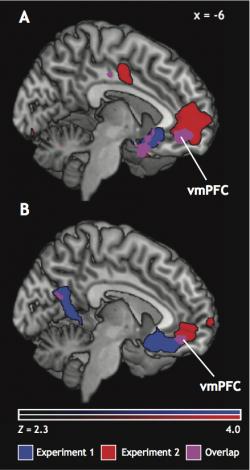
You might be falling in love with that new car, but you probably wouldn't pay as much for it if you could resist the feeling.
Researchers at Duke University who study how the brain values things -- a field called neuroeconomics -- have found that your feelings about something and the value you put on it are calculated similarly in a specific area of the brain.
The region is small area right between the eyes at the front of the brain. It's called the ventromedial prefrontal cortex, or vmPFC for short. Scott Huettel, director of Duke's Center for Interdisciplinary Decision Science, said scientists studying emotion and neuroeconomics had independently singled out this area of the brain in their research but neither group recognized that the other's research was focused on it too.
Now, after a series of experiments in which subjects were asked to modify how they felt about something either positively or negatively, the Duke group is arguing that emotional and economic calculations are more closely related than brain scientists had realized. The study appears July 3 in the Journal of Neuroscience.
Earlier research by other groups had shown the vmPFC participates in calculating the value of rewards and that it is engaged by positive stimuli that aren't really rewards, like a happy memory or a picture of a happy face. A separate line of studies had shown that this brain region also set values on little things like snacks.
The vmPFC handles value tradeoffs such as 'is that product worth parting with my hard-earned money?' "This says that your emotions would enter into that tradeoff," Huettel said.
"The neuroscience fits with your intuitive understanding," said Amy Winecoff, a graduate student in psychology and neuroscience who led the research. "Emotions appear to be relying on the same value system."
In the Duke study, experimental subjects were first trained to do "reappraisal," in which they could change their emotional response to a situation. "In reappraisal you reassess the meaning of an emotional stimulus, rather than trying to avoid the emotional stimulus or suppress your reaction to it," Winecoff said.
While the subjects' brains were being scanned using functional MRI, they were shown images of evocative scenes and faces. After each image the subjects were told to either let their feelings flow or to practice reappraisal to change their thoughts. Then they were asked to rate how positive or negative they felt.
In the case of "an unregulated positive affect" -- letting the good feelings flow -- the vmPFC was shown to be working harder, which the researchers say could be used to predict how much value a person is putting on something. But when the subjects dampened their emotion responses to positive images, the vmPFC activation diminished, as if the images were less valuable to the subjects.
"This changes our frame of reference for thinking about these things," Huettel said. He said advertisers have long been using emotional appeals to get people to value their products, "but they didn't know why it worked."
Previous studies had focused only on reappraisal of negative emotions, but this time around the Duke scientists wanted to watch people reappraise both negative and positive responses. "We have kind of a skewed picture because this has only been done on the negative," Winecoff said.
"It's not the case that you never want to reappraise a positive emotion," said Huettel. But when buying a house or a car, it's a good idea to dampen your infatuation down a bit, he added.
The research was supported by grants from the National Institute of Aging (NIH R21-30771) and the National Institute of Mental Health (NIH P50-60451).